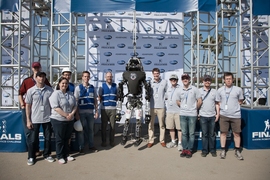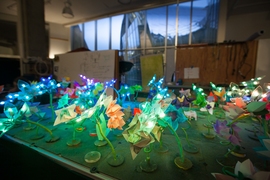It’s been a busy year for MIT’s Computer Science and Artificial Intelligence Laboratory (CSAIL). Researchers won the Turing Award, created groundbreaking algorithms to fix code and detect disease, and developed exciting new robots and artificial-intelligence systems. As 2015 comes to a close, here are a few highlights in seven key areas from the past 12 months:
1. DARPA Robotics Challenge
In June a CSAIL-led robotics team finished mere inches away from winning the finals of the DARPA Robotics Challenge, a U.S. Department of Defense-funded competition to develop a disaster-relief robot.
The team programmed its 6-foot-tall, 400-pound Atlas robot to climb stairs, open doors, and drive a car, all while producing state-of-the-art planning and manipulation algorithms.
2. Machine-assisted medicine
Researchers have developed numerous tools for the fields of health care and medicine, including:
- predictive models that can improve doctors’ abilities to diagnose cancer and detect disorders such as dementia and Parkinson’s disease;
- a method of manipulating our metabolic pathways that may hold the secret to reversing human obesity;
- 3-D-printed models of patients’ hearts for doctors to use to prepare for surgeries; and
- a device, presented to U.S. President Barack Obama at the White House, that uses wireless reflections to detect and predict falls.
3. Robots that dissolve, blossom, and bartend
Robots developed by CSAIL researchers this year include:
- a 1-centimeter-wide microrobot that can swim, climb, walk, bear a load twice its weight, and “self-destruct” by dissolving in water;
- an LED-filled ”robot garden” with over 100 origami robots that crawl, swim, and blossom like flowers;
- A soft robotic gripper that can pick up and identify a wide array of delicate objects by touch alone, including an egg, a CD, and a piece of paper; and
- a team of drink-serving “Beerbots” that demonstrate state-of-the-art planning algorithms allowing robots to collaborate in unpredictable environments.
4. Stonebraker wins $1 million “Nobel Prize for computing”
This year the Association for Computing Machinery’s A.M. Turing Award, often referred to as “the Nobel Prize of computing” and accompanied with a Google-funded $1 million prize, was given to big-data researcher Michael Stonebraker.
Over the past four decades, Stonebraker has revolutionized the field of database management systems and founded nearly a dozen companies, helping spur the multibillion-dollar “big data” industry.
5. Getting their (code) fix
Researchers developed key algorithms aimed at optimizing, fixing, and recovering code:
- Helium helps solve bit-rot, automatically fixing old suboptimal code faster than human engineers;
- CodePhage repairs dangerous software bugs by automatically importing functionality from other, more secure applications, without needing those applications’ source code; and
- DIODE identifies common integer-overflow bugs that often result in malicious hacks.
6. Drones that avoid obstacles
Most drone-related headlines focus on the ones that crash, but that’s because they don’t have our software!
A team from Russ Tedrake’s Robot Locomotion Group developed a self-flying drone that can dart between trees at speeds of 30 miles per hour thanks to a stereo-vision algorithm that allows the drone to detect objects and build a full map of its surroundings in real-time.
7. Cybersecurity at CSAIL
Among the achievements of our cybersecurity researchers this year:
- The launch of three new cross-campus efforts, including the technically-minded Cybersecurity@CSAIL and the Internet Policy Research Initiative;
- An influential report arguing against government backdoors to personal data that was part of efforts spurring President Obama to back down from pushing forth anti-encryption legislation; and
- A paper demonstrating that the popular anonymity-protecting network Tor has key design vulnerabilities that could allow hackers to determine a server’s location or the source of a piece of information.
For updates on the latest lab news, follow CSAIL on Facebook, Twitter and Instagram.













